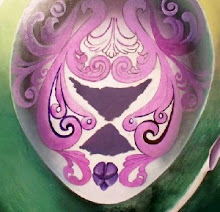
For a long while, I've been very jealous of certain artists who, in addition to creating amazing work, also manage to have an equally strong conceptual basis underpinning their work. Matthew Barney (creation through overcoming physical resistance); Gottfried Helnwein (the consequences of physical violence, especially--intentionally or unintentionally--against children); Patricia Piccinini (the self as refracted through a genetically-modified "Other"); Ron English (a critique of Mass culture through the subversion of commercial imagery)...
And, for many years, I've been frustrated in my own efforts to understand the possible meaning(s) in my own work--or, perhaps, to impose such meanings.
Conceptualism in visual art is usually a double-edged sword; I certainly don't want my work to merely "illustrate" an idea, nor do I want the work to become too "arid", dry, and stale--the "problem" with so much "conceptual" art, IMO, being that the ideas behind the work are far superiour to the work itself. (And, yes, I'll name names: Sol Lewitt, On Kawara, Felix Gonzales-Torres, Joseph Kosuth...)
But, a cleaner understanding of a set of "possible" meanings can have the effect of unifying a body of work, as well as providing ways by which the work can be...complicated, and yet remain thematically unified.
------------------------------------
I'm reading a book at the moment, "Tiny Surrealism: Salvador Dali and the Aesthetics of the Small". Having been singularly impressed by the small paintings at the Dali Retrospective in Philadelphia in 2005, I expected the book to discuss Dali's small works, perhaps explaining their importance in Dali's oeuvre.
But, the book does much more. It places Dali's interest in small things (ants, grasshoppers, breadcrumbs, atoms) within the larger context of his published writings, poems, and personal correspondence. It outlines a conceptual framework that unites much of the imagery in his small paintings as well as his large masterpieces. Further, it shows how the emphasis on small things, combined with Dali's technique (often vilified as merely "illustrative", or ignored completely) was an affront, as well as a response to (and a critique of) both Modernism and Surrealism.
Oddly, I may have found the beginning of a conceptual basis for my next few paintings, ideas Ive had in my head for some time, but which have felt "thin", undeveloped...until now.

No comments:
Post a Comment